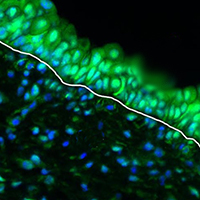Immunohistochemistry as a paramount tool in research of normal urothelium, bladder cancer and bladder pain syndrome

Accepted: 19 March 2021
HTML: 9
All claims expressed in this article are solely those of the authors and do not necessarily represent those of their affiliated organizations, or those of the publisher, the editors and the reviewers. Any product that may be evaluated in this article or claim that may be made by its manufacturer is not guaranteed or endorsed by the publisher.
Authors
The urothelium, an epithelium of the urinary bladder, primarily functions as blood-urine permeability barrier. The urothelium has a very slow turn-over under normal conditions but is capable of extremely fast response to injury. During regeneration urothelium either restores normal function or undergoes altered differentiation pathways, the latter being the cause of several bladder diseases. In this review, we describe the structure of the apical plasma membrane that enables barrier function, the role of urothelium specific proteins uroplakins and the machinery for polarized membrane transports in terminally differentiated superficial umbrella cells. We address key markers, such as keratins, cancer stem cell markers, retinoic acid signalling pathway proteins and transient receptor potential channels and purinergic receptors that drive normal and altered differentiation in bladder cancer and bladder pain syndrome. Finally, we discuss uncertainties regarding research, diagnosis and treatment of bladder pain syndrome. Throughout the review, we emphasise the contribution of immunohistochemistry in advancing our understanding of processes in normal and diseased bladder as well as the most promising possibilities for improved bladder cancer and bladder pain syndrome management.
Supporting Agencies
Slovenian Research Agency ARRSHow to Cite
PAGEPress has chosen to apply the Creative Commons Attribution NonCommercial 4.0 International License (CC BY-NC 4.0) to all manuscripts to be published.
Similar Articles
- E Muñoz, F Gómez, JI Paz, I Casado, Ki-67 immunolabeling in pre-malignant lesions and carcinoma of the prostate. Histological correlation and prognostic evaluation , European Journal of Histochemistry: Vol. 47 No. 2 (2003)
- Manuela Monti, CarloAlberto Redi, Ernesto Capanna, Genome size evaluations in cockroaches: new entries , European Journal of Histochemistry: Vol. 66 No. 2 (2022)
- M Boiani, N Crosetto, CA Redi, Pavia symposium on embryos and stem cells , European Journal of Histochemistry: Vol. 52 No. 1 (2008)
- A Spano, L Sciola, G Monaco, S Barni, Relationship between actin microfilaments and plasma membrane changes during apoptosis of neoplastic cell lines in different culture conditions , European Journal of Histochemistry: Vol. 44 No. 3 (2000)
- C Sarasquete, E Gisbert, L Ribeiro, L Vieira, Mt Dinis, Glyconjugates in epidermal, branchial and digestive mucous cells and gastric glands of gilthead sea bream, Sparus aurata, Senegal sole, Solea senegalensis and Siberian sturgeon, Acipenser baeri development , European Journal of Histochemistry: Vol. 45 No. 3 (2001)
- Manuela Monti, Mouse development - From oocyte to stem cells , European Journal of Histochemistry: Vol. 58 No. 1 (2014)
- Nikolajs Sjakste, Una Riekstiņa, DNA damage and repair in differentiation of stem cells and cells of connective cell lineages: A trigger or a complication? , European Journal of Histochemistry: Vol. 65 No. 2 (2021)
- T Yasui, A Tsukise, T Nara, Y Kuwahara, W Meyer, Morphological, histochemical and immunohistochemical characterization of secretory production of the ciliary glands in the porcine eyelid , European Journal of Histochemistry: Vol. 50 No. 2 (2006)
- G Diaz, M Melis, A Musinu, M Piludu, M Piras, AM Falchi, Localization of MTT formazan in lipid droplets. An alternative hypothesis about the nature of formazan granules and aggregates , European Journal of Histochemistry: Vol. 51 No. 3 (2007)
- Carlo Alberto Redi, Protein misfolding and cellular stress in disease and ageing - Concepts and protocols , European Journal of Histochemistry: Vol. 55 No. 3 (2011)
<< < 58 59 60 61 62 63 64 65 66 67 > >>
You may also start an advanced similarity search for this article.

 https://doi.org/10.4081/ejh.2021.3242
https://doi.org/10.4081/ejh.2021.3242










